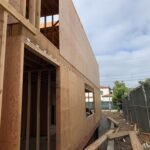In the previous section of our guide, we shared insights into Assembling Your Team. Now, we’d like to tackle one of the most crucial tasks you need to accomplish when you’re building your own home without a general contractor – creating a realistic timeline.
When embarking on the journey of going through an entire home-building process without a general contractor, you absolutely must have a good plan. One of the most critical parts of that plan is developing a realistic and detailed timeline. Time management not only affects the overall duration of your construction project but also plays a significant role in budgeting, resource allocation, and stress reduction. It also contributes to your project’s success. I’m Hovik Akopyan, and through my years in construction, I’ve learned that a well-planned timeline is as foundational to building a house as its concrete footing. This section will guide you through creating a construction timeline that keeps your project on track and moving forward efficiently.
Understanding the Construction Process
Begin by familiarizing yourself with the construction process and the typical sequence of events. A general understanding of each of the construction phases, from site preparation and foundation laying to framing, roofing, and exterior finishes, will help you grasp the overall flow of work. Recognizing dependencies between tasks (e.g., walls cannot be erected before the foundation is set) is crucial for sequencing work correctly.
Consult with Professionals
Although you’re managing the project without a general contractor, consulting with professionals during the planning phase can provide valuable insights into how long each part of the process should take. From the pre-construction process to the final completion of your entire house, you will need advice from experts. Architects, engineers, and experienced tradespeople can offer realistic building timelines based on the scope of your project and local conditions. Have a pre-construction meeting with each professional who can help you prepare for building your own home.
Break Down the Project into Phases
Divide your project into manageable construction phases, each with its own set of milestones and deadlines. Typical phases might include the design phase, site preparation for your plot of land, laying the basement foundation, framing, roofing, electrical and plumbing, drywall and insulation, interior finishes, and landscaping. Assigning start and end dates to each phase helps in monitoring progress and identifying potential delays early.
Factor in Buffer Time
One of the most common mistakes in construction scheduling is failing to account for unforeseen delays. Weather conditions, supply chain issues, construction material delivery delays, labor shortages, or unexpected structural challenges can set your project back. Incorporate buffer time within each phase of your timeline to accommodate these unforeseen events without derailing your overall schedule.
Use Project Management Tools
Leverage project management software or tools to create, adjust, and monitor your timeline. These tools can help you visualize the building process flow, set reminders for critical tasks, and communicate building schedule adjustments with your team. A clear, accessible timeline keeps everyone aligned and accountable.
Regular Reviews and Adjustments
Construction is dynamic, and your timeline should be too. Regularly review your project’s progress against your timeline, adjusting as necessary. Keeping a detailed log of work completed each day can help you track progress and identify trends that may indicate a need for house construction schedule adjustments.
Communicate Changes
When changes to the timeline are necessary, communicate these adjustments to your construction team as soon as possible. Clear communication ensures that all parties are aware of new deadlines and can adjust their work plans accordingly, minimizing the impact on the project’s house construction schedule.
Conclusion
A realistic and accurate timeline is a roadmap that guides your home construction project to successful completion. By understanding the construction process, consulting with professionals, breaking down the project into phases, accounting for buffer time, utilizing project management tools, and maintaining open lines of communication, you can create a timeline that keeps your project on course. Remember, flexibility and adaptability are key; being prepared to adjust your plans as needed will help you navigate the challenges of construction and bring your dream home to life.
In our next section, we’ll explore the importance of effective communication and coordination with your team, a critical factor in ensuring the smooth execution of your project according to your carefully planned timeline.






 Akopi Builders is a Los-Angeles-based general contractor focused on modern design, interiors and landscapes. From our inception, we have delivered exceptional works. As a full-service contractor.
Akopi Builders is a Los-Angeles-based general contractor focused on modern design, interiors and landscapes. From our inception, we have delivered exceptional works. As a full-service contractor.

